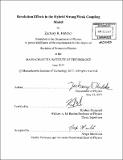| dc.contributor.advisor | Krishna Rajagopal. | en_US |
| dc.contributor.author | Hulcher, Zachary R | en_US |
| dc.contributor.other | Massachusetts Institute of Technology. Department of Physics. | en_US |
| dc.date.accessioned | 2017-10-18T15:08:38Z | |
| dc.date.available | 2017-10-18T15:08:38Z | |
| dc.date.copyright | 2017 | en_US |
| dc.date.issued | 2017 | en_US |
| dc.identifier.uri | http://hdl.handle.net/1721.1/111887 | |
| dc.description | Thesis: S.B., Massachusetts Institute of Technology, Department of Physics, 2017. | en_US |
| dc.description | Cataloged from PDF version of thesis. | en_US |
| dc.description | Includes bibliographical references (pages 33-34). | en_US |
| dc.description.abstract | Within the context of a hybrid strong/weak coupling model of jet quenching, we study the consequences of the fact that the plasma produced in a heavy ion collision cannot resolve the substructure of a collimated parton shower within it to arbitrary resolution. We introduce a screening length parameter, LRes, proportional to the inverse of the local temperature in the plasma, estimating the value of the proportionality constant from both weakly coupled QCD calculations and holographic calculations appropriate in strongly coupled plasma. We then modify the hybrid model so that when a parton in a jet shower splits, its two offspring are initially treated as unresolved, and are only treated as two separate partons losing energy independently after they are separated by a distance LRes. This modification delays the quenching of partons with intermediate energy, resulting in the survival of more hadrons in the final state with PT in the several GeV range. We demonstrate that this effect modifies the jet shapes and jet fragmentations functions, as it makes it more probable for particles carrying a small fraction of the jet energy at larger angles from the jet axis to survive their passage through the quark-gluon plasma. We analyze the consequences of different choices for the value of the resolution length LRes on both partonic and hadronic jet shapes and fragmentation functions, as well as on missing-PT observables. More generally, we discuss the qualitative consequences, and importance, of including the effects of finite resolution. | en_US |
| dc.description.statementofresponsibility | by Zachary R. Hulcher. | en_US |
| dc.format.extent | 34 pages | en_US |
| dc.language.iso | eng | en_US |
| dc.publisher | Massachusetts Institute of Technology | en_US |
| dc.rights | MIT theses are protected by copyright. They may be viewed, downloaded, or printed from this source but further reproduction or distribution in any format is prohibited without written permission. | en_US |
| dc.rights.uri | http://dspace.mit.edu/handle/1721.1/7582 | en_US |
| dc.subject | Physics. | en_US |
| dc.title | Resolution effects in the hybrid strong/weak coupling model | en_US |
| dc.type | Thesis | en_US |
| dc.description.degree | S.B. | en_US |
| dc.contributor.department | Massachusetts Institute of Technology. Department of Physics | |
| dc.identifier.oclc | 1005078183 | en_US |
